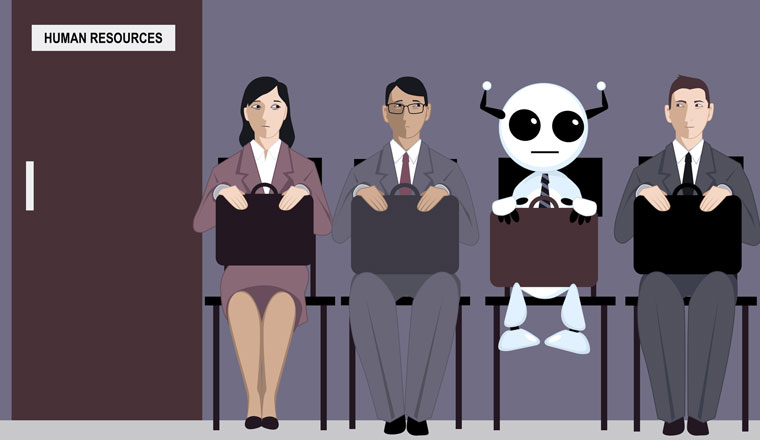Few years ago, recalling the subject of artificial intelligence, the first association that came to everyone’s mind was a robot character from science fiction movies or another machine that aimed at making various activities that would make life easier for a human. Meanwhile, the most popular “robot” used by artificial intelligence is not a machine at all, but a software or other computer program that apart from being programmed to perform a given task, is also a self-learning system which has the skills to constantly increase and improve its knowledge by imitating the process of the human brain. The process includes learning about patterns and insights, how to make the most optimal decision and self-correction that leads to continuous improvement of performance and improvement of results (Krukowska 2018).
The future will be automated and augmented. More and more companies implement various applications using AI to increase the efficiency of their operations and reduce operating costs. The use of AI technology gives us a chance to stand out among the competition. Some roles will be entirely redundant. Many will be replaced in part. Already, complex tasks once considered too difficult to automate are being performed by machines. Automated systems generate complicated medical diagnoses and treatment plans; algorithms create detailed, responsive exercise programmes; and artificially intelligent therapists offer patients low-cost programmes to overcome social anxiety (Krukowska 2018).
Artificial intelligence has become very important in financial institutions and banking. They are using various applications like virtual assistants, chatbots and AI debt collection assistants. It is believed that more than 85% of bank customer interactions will be solely managed by artificial intelligence by 2020 (Reuben 2018). Chatbots are going to become the primary consumer AI apps in the future as banks need to engage with their customers who seek help and information. They are 4 main fields that already helps automated banking systems:
Customer service
Chatbots and various virtual assistants reduce costly and tedious tasks in a call center and provide quick and helpful answers to thousands of customers who contact them every day. Using AI bots, banks can provide real-time, intelligent and personalized help for 24 hours to any potential customer who sends a query via the website, calls the helpline or uses an internet chat, social application or application, etc. AI give users calculated recommendations and help making financial decisions to provide customers with more convenient banking.
Debt Collection
The verification of a potential borrower, and then debt collection. The availability of credit is important for consumers. Having a good loan helps you to live a satisfactory life, buy a car or a flat, etc. With so many important life needs and increasing popularity of loans whose amount and conditions depend on your credit history, the process of approving loans and credit card limits is more important than ever. Artificial intelligence solutions help banks and lenders make smarter decisions to issue a loan, using a number of factors that more accurately assess the credit capabilities of potential borrowers and provide detailed data before taking final steps.
Time optimization
AI process the data and provide a lot of practical information. It helps employees to present them trends, patterns and relationships that serve as key decision-making metrics. Project management tools based on AI help in managing and prioritizing activities through impact analysis. AI also helps in setting deadlines and then generating regular reports for review by management. The expectations of customers regarding quick reaction and convenience are very important.
Recruitment of employees
AI helps HR workers to analyze the completed application form and various pre-filled responses by candidates. It changes the work of the recruiter to a more intelligent, mechanized and based on specific data (searches based on keywords). Artificial intelligence tools can assess employees (their way of thinking and personality), set up and create a plan for areas that employees need to train, how to motivate them, when to reward etc.
Cheaper, more intelligent machines are now simply better efficient workers than the vast majority humans could or will ever be. No healthcare costs, no sick leave, no vacations, no employee turnover, no employee dissatisfaction, the elimination of human errors, declining costs over time as these machines become cheaper, etc. Intelligent automated machines are now essentially automating everything in every field. Economic goods and services are produced by ever cheaper ever more capable intelligent automated machines coupled with permanently declining human jobs and declining wages. According to the KPMG report “Rise of the robots”, in the next 15 years in the financial sector 45% to 75% of human labor will be reduced and replaced by fully automatic robots and systems.
KPMG. (2016). Rise od robots. [online] Warsaw. Available at: https://assets.kpmg/content/dam/kpmg/pdf/2016/06/rise-of-the-robots.pdf, [Accessed 23 Sep. 2019].
Krukowska, M. (2018). Finanse w wyścigu po sztuczną inteligencję. [online] Obserwator Finansowy. Available at: https://www.obserwatorfinansowy.pl/tematyka/bankowosc/finanse-w-wyscigu-po-sztuczna-inteligencje/, [Accessed 25 Sep. 2019].
Reuben, B.(2018). Top 4 Artificial Intelligence Applications in Financial Institutions. [online] Datafloq. Available at: https://datafloq.com/read/4-artificial-intelligence-applications-finance/5721, [Accessed 23 Sep. 2019].

